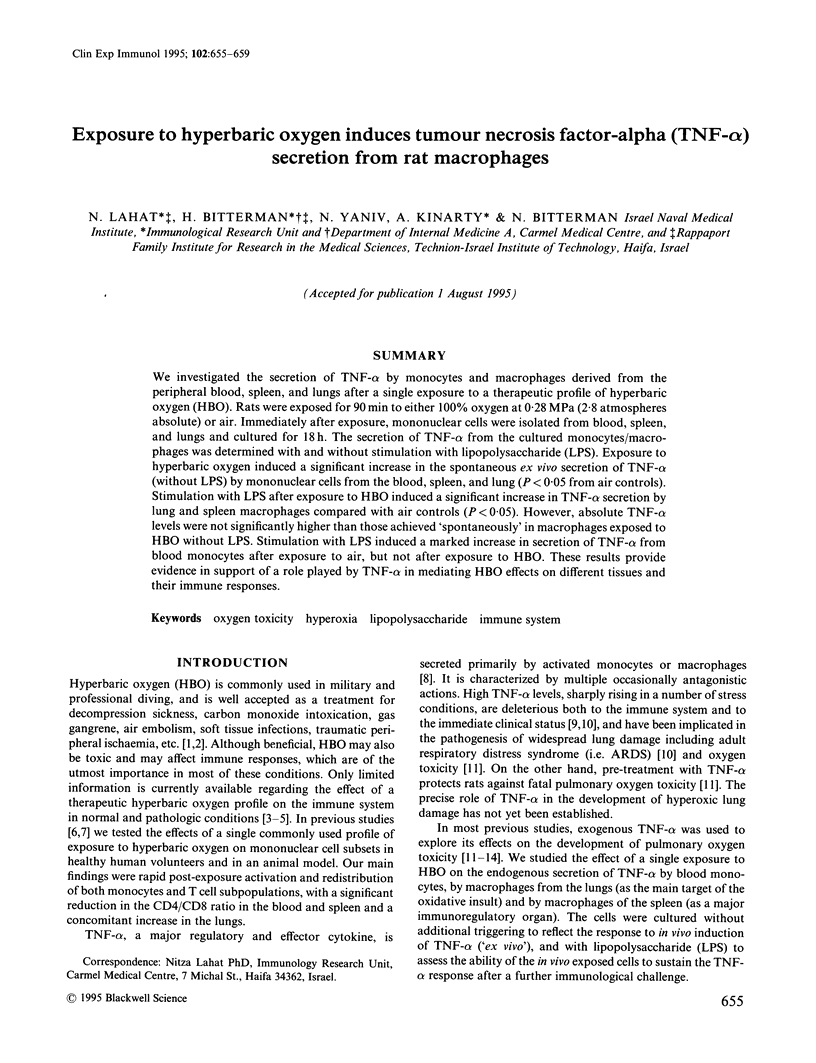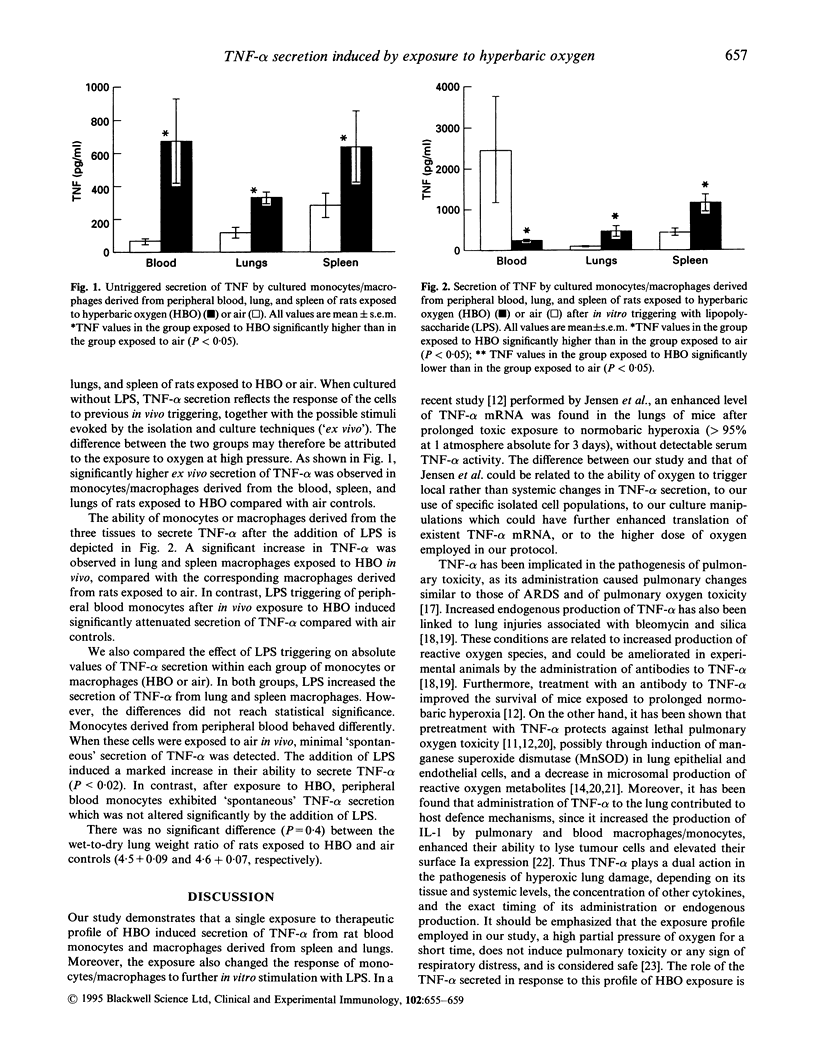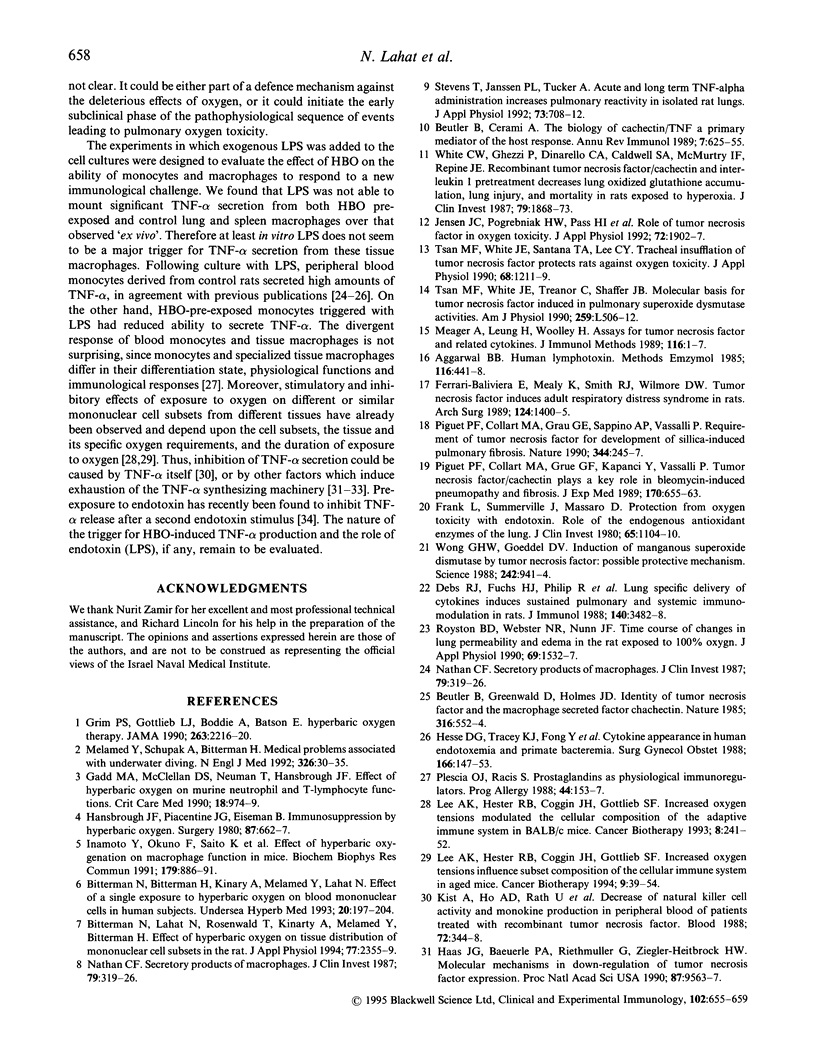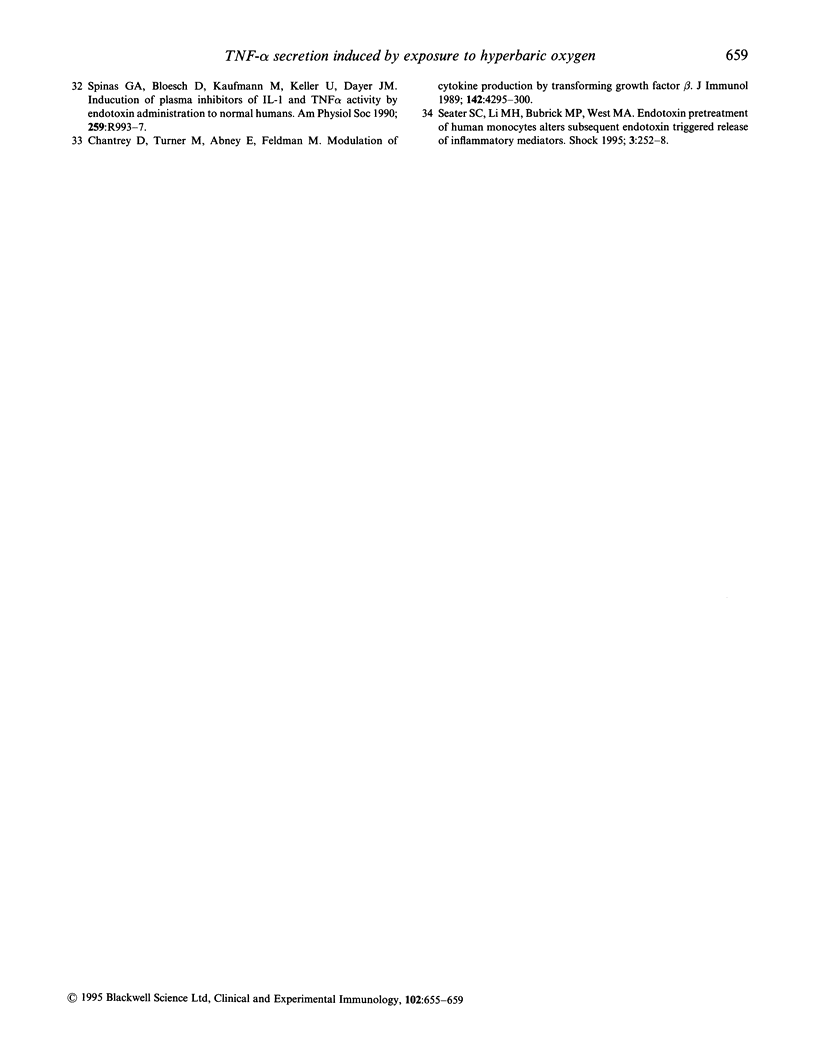Abstract
We investigated the secretion of TNF-alpha by monocytes and macrophages derived from the peripheral blood, spleen, and lungs after a single exposure to a therapeutic profile of hyperbaric oxygen (HBO). Rats were exposed for 90 min to either 100% oxygen at 0.28 MPa (2.8 atmospheres absolute) or air. Immediately after exposure, mononuclear cells were isolated from blood, spleen, and lungs and cultured for 18 h. The secretion of TNF-alpha from the cultured monocytes/macrophages was determined with and without stimulation with lipopolysaccharide (LPS). Exposure to hyperbaric oxygen induced a significant increase in the spontaneous ex vivo secretion of TNF-alpha (without LPS) by mononuclear cells from the blood, spleen, and lung (P < 0.05 from air controls). Stimulation with LPS after exposure to HBO induced a significant increase in TNF-alpha secretion by lung and spleen macrophages compared with air controls (P < 0.05). However, absolute TNF-alpha levels were not significantly higher than those achieved 'spontaneously' in macrophages exposed to HBO without LPS. Stimulation with LPS induced a marked increase in secretion of TNF-alpha from blood monocytes after exposure to air, but not after exposure to HBO. These results provide evidence in support of a role played by TNF-alpha in mediating HBO effects on different tissues and their immune responses.
Full text
PDF




Selected References
These references are in PubMed. This may not be the complete list of references from this article.
- Aggarwal B. B. Human lymphotoxin. Methods Enzymol. 1985;116:441–448. doi: 10.1016/s0076-6879(85)16035-0. [DOI] [PubMed] [Google Scholar]
- Beutler B., Cerami A. The biology of cachectin/TNF--a primary mediator of the host response. Annu Rev Immunol. 1989;7:625–655. doi: 10.1146/annurev.iy.07.040189.003205. [DOI] [PubMed] [Google Scholar]
- Beutler B., Greenwald D., Hulmes J. D., Chang M., Pan Y. C., Mathison J., Ulevitch R., Cerami A. Identity of tumour necrosis factor and the macrophage-secreted factor cachectin. Nature. 1985 Aug 8;316(6028):552–554. doi: 10.1038/316552a0. [DOI] [PubMed] [Google Scholar]
- Bitterman N., Bitterman H., Kinarty A., Melamed Y., Lahat N. Effect of a single exposure to hyperbaric oxygen on blood mononuclear cells in human subjects. Undersea Hyperb Med. 1993 Sep;20(3):197–204. [PubMed] [Google Scholar]
- Bitterman N., Lahat N., Rosenwald T., Kinarty A., Melamed Y., Bitterman H. Effect of hyperbaric oxygen on tissue distribution of mononuclear cell subsets in the rat. J Appl Physiol (1985) 1994 Nov;77(5):2355–2359. doi: 10.1152/jappl.1994.77.5.2355. [DOI] [PubMed] [Google Scholar]
- Chantry D., Turner M., Abney E., Feldmann M. Modulation of cytokine production by transforming growth factor-beta. J Immunol. 1989 Jun 15;142(12):4295–4300. [PubMed] [Google Scholar]
- Debs R. J., Fuchs H. J., Philip R., Montgomery A. B., Brunette E. N., Liggitt D., Patton J. S., Shellito J. E. Lung-specific delivery of cytokines induces sustained pulmonary and systemic immunomodulation in rats. J Immunol. 1988 May 15;140(10):3482–3488. [PubMed] [Google Scholar]
- Ferrari-Baliviera E., Mealy K., Smith R. J., Wilmore D. W. Tumor necrosis factor induces adult respiratory distress syndrome in rats. Arch Surg. 1989 Dec;124(12):1400–1405. doi: 10.1001/archsurg.1989.01410120046010. [DOI] [PubMed] [Google Scholar]
- Frank L., Summerville J., Massaro D. Potection from oxygen toxicity with endotoxin. Role of the endogenous antioxidant enzymes of the lung. J Clin Invest. 1980 May;65(5):1104–1110. doi: 10.1172/JCI109763. [DOI] [PMC free article] [PubMed] [Google Scholar]
- Gadd M. A., McClellan D. S., Neuman T. S., Hansbrough J. F. Effect of hyperbaric oxygen on murine neutrophil and T-lymphocyte functions. Crit Care Med. 1990 Sep;18(9):974–979. doi: 10.1097/00003246-199009000-00014. [DOI] [PubMed] [Google Scholar]
- Grim P. S., Gottlieb L. J., Boddie A., Batson E. Hyperbaric oxygen therapy. JAMA. 1990 Apr 25;263(16):2216–2220. [PubMed] [Google Scholar]
- Haas J. G., Baeuerle P. A., Riethmüller G., Ziegler-Heitbrock H. W. Molecular mechanisms in down-regulation of tumor necrosis factor expression. Proc Natl Acad Sci U S A. 1990 Dec;87(24):9563–9567. doi: 10.1073/pnas.87.24.9563. [DOI] [PMC free article] [PubMed] [Google Scholar]
- Hansbrough J. F., Piacentine J. G., Eiseman B. Immunosuppression by hyperbaric oxygen. Surgery. 1980 Jun;87(6):662–667. [PubMed] [Google Scholar]
- Hesse D. G., Tracey K. J., Fong Y., Manogue K. R., Palladino M. A., Jr, Cerami A., Shires G. T., Lowry S. F. Cytokine appearance in human endotoxemia and primate bacteremia. Surg Gynecol Obstet. 1988 Feb;166(2):147–153. [PubMed] [Google Scholar]
- Inamoto Y., Okuno F., Saito K., Tanaka Y., Watanabe K., Morimoto I., Yamashita U., Eto S. Effect of hyperbaric oxygenation on macrophage function in mice. Biochem Biophys Res Commun. 1991 Sep 16;179(2):886–891. doi: 10.1016/0006-291x(91)91901-n. [DOI] [PubMed] [Google Scholar]
- Jensen J. C., Pogrebniak H. W., Pass H. I., Buresh C., Merino M. J., Kauffman D., Venzon D., Langstein H. N., Norton J. A. Role of tumor necrosis factor in oxygen toxicity. J Appl Physiol (1985) 1992 May;72(5):1902–1907. doi: 10.1152/jappl.1992.72.5.1902. [DOI] [PubMed] [Google Scholar]
- Kist A., Ho A. D., Räth U., Wiedenmann B., Bauer A., Schlick E., Kirchner H., Männel D. N. Decrease of natural killer cell activity and monokine production in peripheral blood of patients treated with recombinant tumor necrosis factor. Blood. 1988 Jul;72(1):344–348. [PubMed] [Google Scholar]
- Lee A. K., Hester R. B., Coggin J. H., Gottlieb S. F. Increased oxygen tensions influence subset composition of the cellular immune system in aged mice. Cancer Biother. 1994 Spring;9(1):39–54. doi: 10.1089/cbr.1994.9.39. [DOI] [PubMed] [Google Scholar]
- Lee A. K., Hester R. B., Coggin J. H., Gottlieb S. F. Increased oxygen tensions modulate the cellular composition of the adaptive immune system in BALB/c mice. Cancer Biother. 1993 Fall;8(3):241–252. doi: 10.1089/cbr.1993.8.241. [DOI] [PubMed] [Google Scholar]
- Meager A., Leung H., Woolley J. Assays for tumour necrosis factor and related cytokines. J Immunol Methods. 1989 Jan 6;116(1):1–17. doi: 10.1016/0022-1759(89)90306-2. [DOI] [PubMed] [Google Scholar]
- Melamed Y., Shupak A., Bitterman H. Medical problems associated with underwater diving. N Engl J Med. 1992 Jan 2;326(1):30–35. doi: 10.1056/NEJM199201023260105. [DOI] [PubMed] [Google Scholar]
- Nathan C. F. Secretory products of macrophages. J Clin Invest. 1987 Feb;79(2):319–326. doi: 10.1172/JCI112815. [DOI] [PMC free article] [PubMed] [Google Scholar]
- Nathan C. F. Secretory products of macrophages. J Clin Invest. 1987 Feb;79(2):319–326. doi: 10.1172/JCI112815. [DOI] [PMC free article] [PubMed] [Google Scholar]
- Piguet P. F., Collart M. A., Grau G. E., Kapanci Y., Vassalli P. Tumor necrosis factor/cachectin plays a key role in bleomycin-induced pneumopathy and fibrosis. J Exp Med. 1989 Sep 1;170(3):655–663. doi: 10.1084/jem.170.3.655. [DOI] [PMC free article] [PubMed] [Google Scholar]
- Piguet P. F., Collart M. A., Grau G. E., Sappino A. P., Vassalli P. Requirement of tumour necrosis factor for development of silica-induced pulmonary fibrosis. Nature. 1990 Mar 15;344(6263):245–247. doi: 10.1038/344245a0. [DOI] [PubMed] [Google Scholar]
- Plescia O. J., Racis S. Prostaglandins as physiological immunoregulators. Prog Allergy. 1988;44:153–171. [PubMed] [Google Scholar]
- Royston B. D., Webster N. R., Nunn J. F. Time course of changes in lung permeability and edema in the rat exposed to 100% oxygen. J Appl Physiol (1985) 1990 Oct;69(4):1532–1537. doi: 10.1152/jappl.1990.69.4.1532. [DOI] [PubMed] [Google Scholar]
- Seatter S. C., Li M. H., Bubrick M. P., West M. A. Endotoxin pretreatment of human monocytes alters subsequent endotoxin-triggered release of inflammatory mediators. Shock. 1995 Apr;3(4):252–258. doi: 10.1097/00024382-199504000-00002. [DOI] [PubMed] [Google Scholar]
- Spinas G. A., Bloesch D., Kaufmann M. T., Keller U., Dayer J. M. Induction of plasma inhibitors of interleukin 1 and TNF-alpha activity by endotoxin administration to normal humans. Am J Physiol. 1990 Nov;259(5 Pt 2):R993–R997. doi: 10.1152/ajpregu.1990.259.5.R993. [DOI] [PubMed] [Google Scholar]
- Stevens T., Janssen P. L., Tucker A. Acute and long-term TNF-alpha administration increases pulmonary vascular reactivity in isolated rat lungs. J Appl Physiol (1985) 1992 Aug;73(2):708–712. doi: 10.1152/jappl.1992.73.2.708. [DOI] [PubMed] [Google Scholar]
- Tsan M. F., White J. E., Santana T. A., Lee C. Y. Tracheal insufflation of tumor necrosis factor protects rats against oxygen toxicity. J Appl Physiol (1985) 1990 Mar;68(3):1211–1219. doi: 10.1152/jappl.1990.68.3.1211. [DOI] [PubMed] [Google Scholar]
- White C. W., Ghezzi P., Dinarello C. A., Caldwell S. A., McMurtry I. F., Repine J. E. Recombinant tumor necrosis factor/cachectin and interleukin 1 pretreatment decreases lung oxidized glutathione accumulation, lung injury, and mortality in rats exposed to hyperoxia. J Clin Invest. 1987 Jun;79(6):1868–1873. doi: 10.1172/JCI113029. [DOI] [PMC free article] [PubMed] [Google Scholar]
- Wong G. H., Goeddel D. V. Induction of manganous superoxide dismutase by tumor necrosis factor: possible protective mechanism. Science. 1988 Nov 11;242(4880):941–944. doi: 10.1126/science.3263703. [DOI] [PubMed] [Google Scholar]


